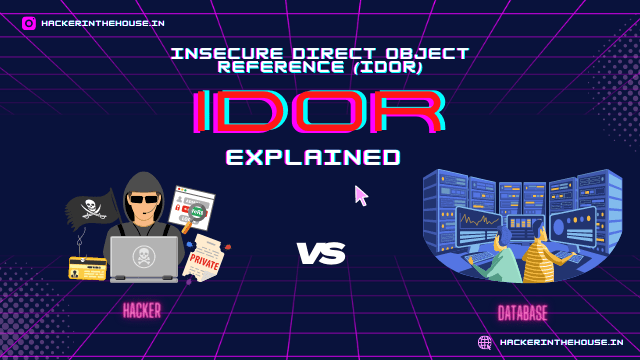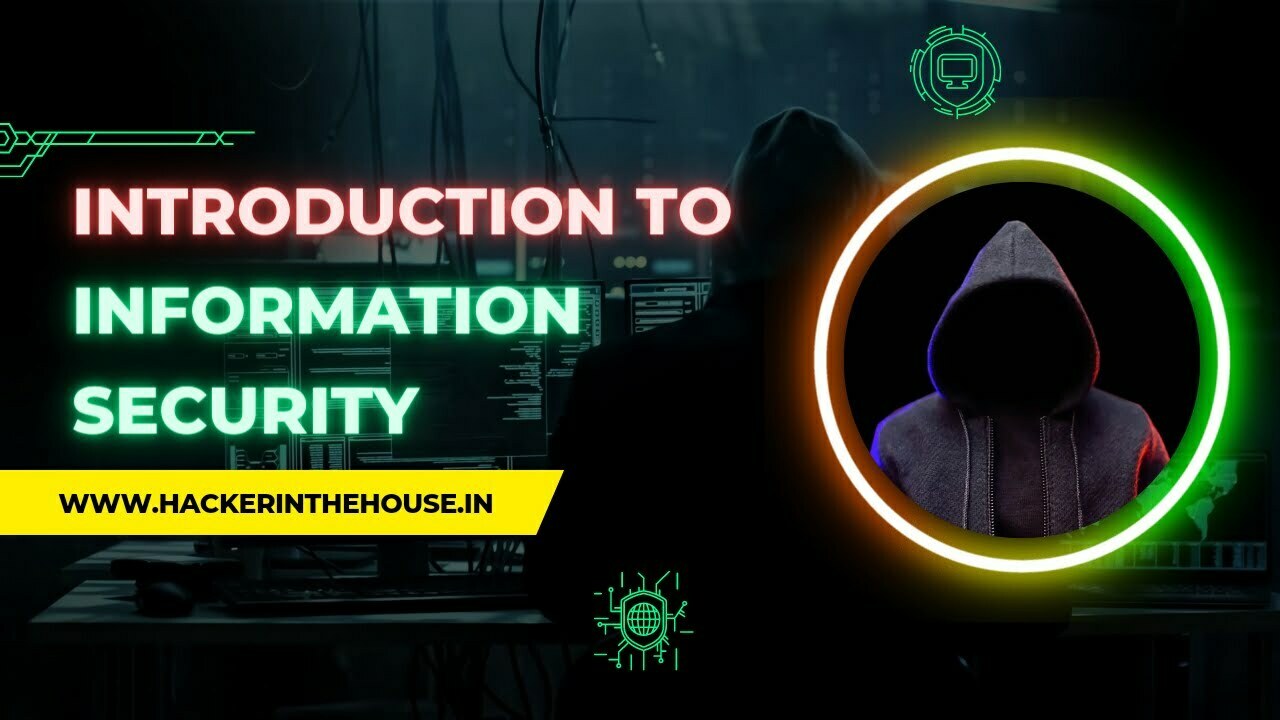Introduction to Information Security
What is Information Security?
Information security is the practice of protecting information and information systems from unauthorized access, use, disclosure, disruption, modification, or destruction. It involves safeguarding the confidentiality, integrity, and availability of data and the systems that
store, process, and transmit it.
Information security involves a range of measures and technologies designed to protect against cyber threats such as hacking, malware, and phishing attacks, as well as other types of threats like physical theft or damage to computer hardware. It also involves policies,
procedures, and protocols for managing and protecting sensitive information and for responding to security breaches or incidents.
Effective information security is crucial for organizations of all sizes and types, as it helps to protect sensitive data and maintain the trust of customers, employees, and other stakeholders. It is an ongoing process that requires constant vigilance and updates to stay ahead of evolving threats and to ensure that an organization’s data and systems are secure.
What is the difference between cybersecurity and information security?
Cybersecurity and information security are often used interchangeably, but they refer to slightly different things.
Information security is a broad term that refers to the practice of protecting information and information systems from unauthorized access, use, disclosure, disruption, modification, or destruction. It involves safeguarding the confidentiality, integrity, and availability of data and the systems that store, process, and transmit it. Information security encompasses a range of measures and technologies designed to protect against various types of threats, including cyber threats like hacking, malware, and phishing attacks, as well as other types of threats like physical theft or damage to computer hardware.
Cybersecurity, on the other hand, specifically refers to the practice of protecting computers, networks, and other information systems from cyber attacks. It involves the use of technologies, processes, and policies to secure these systems against unauthorized access or attacks from cybercriminals, hackers, and other malicious actors. Cybersecurity is a key component of information security, but it is focused specifically on protecting against cyber threats.
In summary, information security is a broad term that encompasses cybersecurity and other measures and technologies designed to protect information and information systems, while cybersecurity is a specific aspect of information security that focuses on protecting against cyber threats.
Why is information security important for all companies?
Information security is important for all companies for several reasons:
1. Protect sensitive information: Companies often have sensitive information such as financial data, customer records, and intellectual property that needs to be protected from unauthorized access, use, or disclosure. Information security helps to ensure that this sensitive information is kept confidential and only accessed by authorized individuals.
2. Maintain the trust of customers and stakeholders: Customers and stakeholders expect companies to protect their personal and sensitive information. A security breach or data leak can damage an organization’s reputation and lead to a loss of trust. Information security helps to maintain the trust of customers and stakeholders by demonstrating that the company is taking steps to protect sensitive information.
3. Comply with regulations and laws: Many industries are subject to regulations and laws that require companies to implement certain information security measures. For example, the Health Insurance Portability and Accountability Act (HIPAA) in the U.S. requires healthcare organizations to implement certain security measures to protect the privacy of patient information. Information security helps companies to comply with these regulations and laws.
4. Avoid financial losses: A security breach or data leak can result in financial losses for a company. For example, a company may incur costs to investigate and respond to the breach, as well as potential legal and regulatory fines. Information security helps to minimize the risk of financial losses caused by security breaches or data leaks.
5. Protect against cyber threats: Cyber threats such as hacking, malware, and phishing attacks are becoming increasingly common, and they can have serious consequences for companies. Information security helps to protect against these types of threats by implementing measures such as firewalls, antivirus software, and user authentication.
Overall, information security is important for all companies because it helps to protect sensitive information, maintain the trust of customers and stakeholders, comply with regulations and laws, avoid financial losses, and protect against cyber threats.
What are the purpose and objectives of information security?
The purpose of information security is to protect information and information systems from unauthorized access, use, disclosure, disruption, modification, or destruction. The main objectives of information security are:
1. Confidentiality: This refers to the protection of information from unauthorized access or disclosure. Information security measures are designed to ensure that sensitive information is only accessed by authorized individuals.
2. Integrity: This refers to the protection of information from unauthorized modification or destruction. Information security measures are designed to ensure that information is accurate and complete and that it cannot be tampered with or corrupted.
3. Availability: This refers to the ability of authorized users to access information when they need it. Information security measures are designed to ensure that information and systems are available to authorized users at all times.
Overall, the main objectives of information security are to protect the confidentiality, integrity, and availability of information and information systems.
Who is responsible for information security?
Information security is the responsibility of everyone in an organization. While there may be specific individuals or teams responsible for implementing and managing information security measures, it is important for all employees to understand the importance of information security and to follow security protocols and procedures.
Generally, the chief information officer (CIO) or chief information security officer (CISO) is responsible for developing and implementing the organization’s information security strategy and policies. They may oversee a team of information security professionals who are responsible for managing security measures such as firewalls, antivirus software, and user authentication.
However, it is important for all employees to play a role in maintaining the security of an organization’s information and systems. This may include:
• Using strong passwords and keeping them confidential
• Not sharing login credentials
• Reporting any security incidents or concerns
• Following security protocols when handling sensitive information
• Not clicking on links or downloading attachments from unknown sources
Overall, information security is the responsibility of everyone in an organization, from upper management to individual employees.
How to engage the top management in information security initiatives?
Here are some strategies for engaging top management in information security initiatives:
1. Communicate the importance of information security: It is important to clearly explain the risks and consequences of poor information security, and how it can impact the organization’s reputation, financial performance, and compliance with regulations and laws.
2. Share success stories: Share examples of how effective information security measures have helped the organization to avoid security breaches or incidents, and how they have contributed to the organization’s overall success.
3. Align information security initiatives with business goals: Show how information security initiatives support the organization’s overall business goals and objectives. For example, if one of the organization’s goals is to increase customer trust, explain how information security measures help to protect customer data and maintain trust.
4. Involve top management in the planning process: Invite top management to participate in the planning and decision-making process for information security initiatives. This helps to ensure that they are fully informed and invested in the success of the initiatives.
5. Provide ongoing training and support: Offer ongoing training and support to top management and other employees to help them understand the importance of information security and how to follow security protocols and procedures.
Overall, it is important to clearly communicate the importance of information security, align it with business goals, involve top management in the planning process, and provide ongoing training and support to ensure their engagement in information security initiatives.
What kind of resources are needed for information security?
There are several types of resources that may be needed for information security:
1. People: This includes employees who are responsible for implementing and managing information security measures, as well as employees who are trained to follow security protocols and procedures.
2. Technology: This includes hardware and software tools that are used to implement security measures such as firewalls, antivirus software, and user authentication.
3. Policies and procedures: This includes guidelines and protocols for managing and protecting sensitive information, as well as procedures for responding to security breaches or incidents.
4. Training and education: This includes programs and resources for training employees on information security best practices and procedures.
5. Budget: Adequate budget is necessary to support the acquisition and maintenance of the people, technology, and other resources needed for information security.
Overall, a combination of people, technology, policies and procedures, training and education, and budget are necessary for effective information security.
How to implement information security?
Here are some steps for implementing information security:
1. Conduct a risk assessment: Conduct a risk assessment to identify the types of threats that the organization is most likely to face and the potential consequences of those threats. This will help to prioritize the implementation of security measures.
2. Develop a security policy: Develop a security policy that outlines the organization’s information security goals and objectives, as well as the measures and procedures that will be implemented to achieve those goals.
3. Implement security measures: Based on the results of the risk assessment and the goals and objectives outlined in the security policy, implement security measures such as firewalls, antivirus software, and user authentication.
4. Train employees: Provide training to employees on information security best practices and procedures, and ensure that they understand their responsibilities in maintaining the security of the organization’s information and systems.
5. Monitor and review: Regularly monitor and review the effectiveness of the organization’s information security measures and make any necessary updates or changes.
Overall, implementing information security involves conducting a risk assessment, developing a security policy, implementing security measures, training employees, and regularly monitoring and reviewing the effectiveness of those measures.
What information security standard or framework can help with the implementation?
There are several information security standards and frameworks that can help with the implementation of information security measures. Some of the most widely recognized include:
1. ISO/IEC 27001: This is an international standard that outlines a framework for establishing, implementing, maintaining, and continually improving an organization’s information security management system.
2. NIST Cybersecurity Framework (CSF): Developed by the National Institute of Standards and Technology (NIST), the CSF is a risk-based framework that helps organizations to identify, prioritize, and mitigate cyber risks.
3. COBIT: Developed by the Information Systems Audit and Control Association (ISACA), COBIT is a framework that helps organizations to manage, monitor, and optimize information and technology (IT) resources.
4. PCI DSS: The Payment Card Industry Data Security Standard (PCI DSS) is a set of security standards that apply to organizations that accept, process, store, or transmit credit card information.
5. HIPAA: The Health Insurance Portability and Accountability Act (HIPAA) is a U.S. law that requires healthcare organizations to implement certain security measures to protect the privacy of patient information.
Using a recognized information security standard or framework can help organizations to develop a comprehensive and effective information security program, and to ensure that they are meeting industry best practices and regulatory requirements.
How to communicate information security objectives, principles, and requirements through the organisation?
Here are some strategies for communicating information security objectives, principles, and requirements throughout an organization:
1. Develop clear and concise policies and procedures: Develop clear and concise policies and procedures that outline the organization’s information security objectives, principles, and requirements. Make sure these documents are easily accessible to all employees.
2. Provide training and education: Provide training and education to all employees on information security best practices and procedures, and ensure that they understand their responsibilities in maintaining the security of the organization’s information and systems.
3. Communicate regularly: Regularly communicate information security updates and reminders to all employees through emails, newsletters, and other channels.
4. Use visible reminders: Use visible reminders such as posters and signage to remind employees of important information security protocols and procedures.
5. Encourage a culture of security: Encourage a culture of security throughout the organization by promoting the importance of information security and recognizing employees who demonstrate good security practices.
Overall, effective communication is key to ensuring that all employees understand and follow the organization’s information security objectives, principles, and requirements. It is important to use a variety of methods and channels to communicate this information and to make it easily accessible to all employees.
How to find and engage information security champions? What are their roles?
Information security champions are employees who are passionate about information security and who are willing to take on a leadership role in promoting and implementing security measures within the organization. Here are some steps for finding and engaging information security champions:
1. Identify potential candidates: Look for employees who demonstrate an interest in information security and who have the skills and knowledge necessary to take on a leadership role.
2. Engage potential champions: Engage potential champions in information security initiatives and provide them with opportunities to learn more about security best practices and technologies.
3. Provide support and resources: Provide information security champions with the support and resources they need to succeed in their role, such as access to training and education, and the budget and resources needed to implement security measures.
The roles of information security champions may include:
• Promoting the importance of information security throughout the organization
• Leading the implementation of security measures and initiatives
• Providing guidance and training to other employees on security best practices and procedures
• Monitoring and reviewing the effectiveness of the organization’s security measures
• Serving as a resource for other employees on information security-related questions or concerns
Overall, information security champions play a key role in promoting and implementing information security within an organization. They help to raise awareness of security best practices and serve as a resource for other employees on security-related matters.
What is information security culture? How to improve it?
Information security culture refers to the values, beliefs, and behaviors related to information security that are shared by members of an organization. A strong information security culture is one in which all employees understand the importance of protecting sensitive information and follow security protocols and procedures.
Here are some ways to improve information security culture:
1. Communicate the importance of information security: Clearly communicate the risks and consequences of poor information security, and how it can impact the organization’s reputation, financial performance, and compliance with regulations and laws.
2. Provide training and education: Provide training and education to all employees on information security best practices and procedures, and ensure that they understand their responsibilities in maintaining the security of the organization’s information and systems.
3. Encourage a culture of continuous improvement: Encourage a culture of continuous improvement by regularly reviewing and updating the organization’s information security measures and procedures.
4. Recognize and reward good security practices: Recognize and reward employees who demonstrate good security practices and behavior. This can help to encourage a culture of security throughout the organization.
5. Involve employees in the planning and decision-making process: Involve employees in the planning and decision-making process for information security initiatives. This helps to ensure that they are invested in the success of the initiatives and feel a sense of ownership over the organization’s information security practices.
Overall, improving information security culture requires a focus on clear communication, training and education, continuous improvement, recognition and reward, and employee involvement.
How to handle information security incidents?
Handling information security incidents effectively is crucial for minimizing the impact of a security breach and restoring normal operations as quickly as possible. Here are some steps you can follow when handling an information security incident:
1. Identify the incident: Determine the nature and scope of the incident, including what assets may have been affected and the potential impact on the organization.
2. Contain the incident: Take immediate action to stop the incident from spreading or escalating. This may involve disconnecting affected systems from the network, shutting down servers, or revoking access to certain resources.
3. Investigate the incident: Conduct a thorough investigation to identify the root cause of the incident and determine how it occurred.
4. Communicate with relevant parties: Keep relevant parties, such as management, IT staff, and legal counsel, informed about the incident and its progress.
5. Restore normal operations: Take steps to restore normal operations as quickly as possible, including repairing any damage and implementing any necessary security measures to prevent future incidents.
6. Evaluate and learn from the incident: After the incident has been resolved, conduct a thorough review to identify any weaknesses or vulnerabilities that may have contributed to the incident. Use this information to improve your organization’s information security posture and prevent future incidents.
By following these steps, you can effectively handle an information security incident and minimize the impact on your organization.
How to assess information security?
There are several steps involved in assessing information security:
1. Identify the scope of the assessment: Determine what information and systems need to be included in the assessment.
2. Gather information: Gather information about the organization’s current information security practices, including policies and procedures, technologies and tools, and employee training and awareness.
3. Identify risks and vulnerabilities: Identify potential risks and vulnerabilities that could impact the organization’s information and systems. This may involve conducting a risk assessment to identify the types of threats that the organization is most likely to face and the potential consequences of those threats.
4. Evaluate the effectiveness of current security measures: Evaluate the effectiveness of the organization’s current security measures in protecting against identified risks and vulnerabilities.
5. Identify areas for improvement: Identify areas where the organization’s information security practices could be improved, and develop a plan for addressing those areas.
6. Implement and monitor improvements: Implement the identified improvements and monitor their effectiveness in improving the organization’s information security posture.
Overall, assessing information security involves identifying the scope of the assessment, gathering information, identifying risks and vulnerabilities, evaluating the effectiveness of current security measures, identifying areas for improvement, and implementing and monitoring improvements.
What are three of the most helpful information security metrics (indicators)?
There are many different metrics that can be used to measure the effectiveness of an organization’s information security practices. Here are three of the most helpful information security metrics:
1. Number of security incidents: Tracking the number of security incidents that occur within an organization can help to identify trends and areas for improvement.
2. Time to detect and respond to security incidents: Tracking the time it takes to detect and respond to security incidents can help to identify areas where the organization’s incident response process can be improved.
3. Percentage of successful phishing attacks: Tracking the percentage of successful phishing attacks can help to measure the effectiveness of the organization’s employee training and awareness programs.
Overall, these three metrics can help to provide valuable insights into an organization’s information security posture and identify areas for improvement.
How to continuously improve information security?
There are several steps you can take to continuously improve information security:
1. Conduct regular risk assessments: Identify and assess the risks to your organization’s information and systems on a regular basis. This will help you prioritize your efforts and allocate resources effectively.
2. Implement strong security controls: Implement strong security controls, such as firewalls, antivirus software, and intrusion detection systems, to protect your systems and data from threats.
3. Train employees: Educate your employees on security best practices, such as creating strong passwords, avoiding phishing attacks, and handling sensitive data responsibly.
4. Stay up to date with security threats: Keep up to date with the latest threats and vulnerabilities by subscribing to security newsletters, attending industry conferences, and following security experts on social media.
5. Regularly review and update your security policies: Review and update your security policies and procedures on a regular basis to ensure that they are still effective and relevant.
6. Conduct penetration testing: Regularly conduct penetration testing to identify and address vulnerabilities in your systems and networks.
7. Use security tools: Use security tools such as vulnerability scanners and log analysis tools to identify and address potential security issues.
8. Monitor your systems: Monitor your systems for unusual activity and suspicious behavior, and take appropriate action if any is detected.
By following these steps, you can continuously improve your organization’s information security posture and protect against potential threats.
What are the main challenges for information security?
There are several challenges that organizations face when it comes to information security:
1. Managing complex environments: Modern organizations have complex IT environments, with multiple devices, systems, and networks that need to be secured. This complexity makes it difficult to identify and address potential vulnerabilities.
2. Lack of resources: Many organizations do not have the necessary resources, including personnel and budget, to effectively implement and maintain strong security measures.
3. Keeping up with new threats: The threat landscape is constantly evolving, with new threats and vulnerabilities emerging all the time. It can be difficult for organizations to keep up with these changes and implement the necessary protections.
4. User error: Human error is a common cause of security breaches. Employees may accidentally expose the organization to risk through actions such as using weak passwords or falling victim to phishing attacks.
5. Regulatory compliance: Organizations may be subject to a variety of regulations and industry standards that require them to implement specific security measures. Meeting these requirements can be a challenge, especially if they are constantly changing.
6. Integration of security measures: Integrating security measures into existing systems and processes can be difficult, as it requires a significant amount of planning and coordination.
By addressing these challenges, organizations can improve their information security posture and protect against potential threats.
We will explore more in our next upcoming blogs…
Thank you for reading!











Leave a Reply